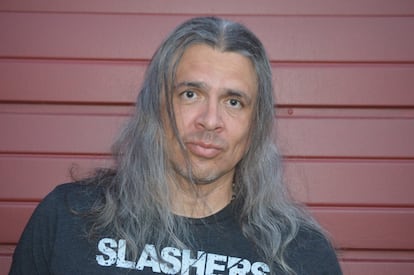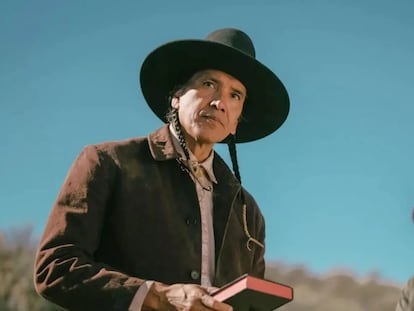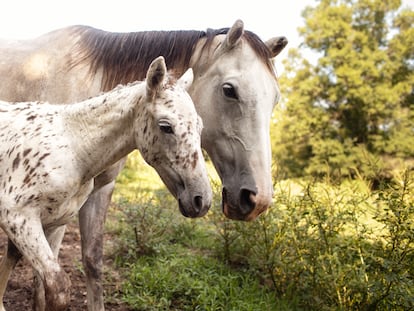Stephen Graham Jones: The horror novel helps settle scores for the massacre of American Indians
Representative of the new North American horror narrative, the author received an award at the Sui Generis festival in Madrid, Spain

There’s a story that horror writer Stephen Graham Jones can’t get out of his head. He heard it in a talk by Joseph M. Marshall III, the foremost authority on American Indian memory. Early one morning, a car is driving along a lonely highway in the great Dakota plains. In a curve, its headlights draw the silhouette of four Indian horsemen in war paint riding their animals. The ghostly vision — from the past or the future, who knows? — crosses the asphalt without stepping on it and continues its journey into the night. To Jones’s mind, this tale, which could be told around a campfire, translates into an unfinished story: “[It’s] our [story], that of the Indians, in this instant and in this place called America for the moment. It means that our story is not yet complete, and this place can be ours again. They took all these lands, but what about those territories in the dark that remain hidden from the white eye? We Indians can teach a thing or two about that,” he writes in the preface to Never Whistle at Night: An Indigenous Dark Fiction Anthology, which brings together some of the most vibrant voices in American Indian writing today.
Texas-born Stephen Graham Jones, 51, reigns supreme in that genre. The author of some 30 books, he achieved fame thanks to The Only Good Indians (2020). In it, the horror embodied by the vengeful spirit of a deer-headed woman does not overshadow the other real horrors faced by the protagonists, four Blackfeet people who are relegated to a marginal place in current American society. Today, Graham Jones is one of the world’s most acclaimed horror writers. He received another award, the Sheridan Le Fanu, at the fifteenth anniversary of the Sui Generis festival, which was recently held in Madrid; other heavyweights of the genre, including Paul Tremblay and S. T. Joshi, Lovecraft’s biographer, also attended.
The novel presented at the Madrid award ceremony, My Heart is a Chainsaw, has won the Bram Stoker, Shirley Jackson and Locus awards. As the title suggests, it is a tribute to the slasher movie, that film subgenre that features a bloody psychopath and young people destined to become mincemeat as its main ingredients and has gained recognition in recent years. As Jones himself notes in a phone conversation from his home in Colorado, “It’s happening with horror in general. Possibly since Jordan Peele’s film Get Out (2017) and Victor LaValle’s novel The Ballad of Black Tom (2016), in the genre we have shown that we know how to dialogue with the problems we face as a society. We are no longer watching from the sidelines; we have jumped onto the playing field. The problem would be watering down our identity and our ideals just because we have been given a seat at the table, because we insist on being polite. So far, that hasn’t happened; fingers crossed.”

That isn’t an issue in My Heart is a Chainsaw. The half-Indian, half-white protagonist is a teenage girl who protects herself from a hostile world by looking at life through the mask of Jason Voorhees, the psychopath from Friday the 13th… until her small town facing gentrification becomes a bloodbath. Along the way, the author subverts horror clichés like the final girl, the survivor of the carnage who confronts the killer, who is usually more akin to, say, beautiful white actress Neve Campbell (from the iconic Scream franchise) than the heroine of this novel. “Its lack of inclusivity is one of the most unfortunate and damaging aspects of the slasher movie. With this, I’d like to think that I’m opening the door for more and more people to solve that.” Jones’s literary power resides precisely in his ability to transcend the genre. Underneath the fright, there’s a scathing critique of the situation of Indigenous people in the U.S. today.
The movement for reparations to start to make amends for the genocide and displacement of Indigenous people has taken shape in horror literature and films in recent years. Films like Jeff Barnaby’s Blood Quantum (2019), in which only the Indian population is spared from the zombie contagion, and the works of writers like Shane Hawk, Nick Medina and Darcie Little Badger take the reins of a narrative that has traditionally belonged to the white man. As Professor Kali Simmons, the author of the monograph The Savage Screen: Indigeneity in the Modern American Horror Film, explains, “living under the conditions of colonialism as an Indigenous person is to exist within a terrifying structure of dispossession and violence. And yet, American cinema has tended to imagine the opposite, presenting white settlers and the colonial state as victims of terrifying Indians seeking violent revenge.”
The trope of the murderous Indian emerged in the captivity narratives disseminated throughout the seventeenth, eighteenth and nineteenth centuries by European settlers in which they essentially portrayed themselves as people besieged and abducted by aboriginal savages. Professor Roy Harvey Pearce collected many of these written testimonies in his study The Significances of the Captivity Narrative (1947); he concluded that, while they all seem to arise from real experiences, “they evolved into patterns that were reproduced over and over again, drifting into something terrible and strange, adopting the language of a crazed gazetteer more typical of a pulp thriller.”
At the age of 11, Stephen Graham Jones’s first literary crush was Louis L’Amour, a writer of cowboy and Indian novels. Half of L’Amour’s 85 works were adapted for film or television, serving as perfect vehicles for propagandizing the American way of life that Jones has learned to dismantle over the years. “For better or worse, those pulp westerns are now part of my DNA as a writer. Only as an adult have I learned to reject their vision of an uninhabited America [that was] free for the taking; that this thing called ‘progress’ was inevitable; that all the violence committed is part of what it takes to ‘tame the land’; that American Indians exist in the past, not the present.” The terror visited upon natives of the past extends into the present day through another common trope: the Indian burial ground. The house in The Amityville Horror sits atop one; the one in Poltergeist does too. The cat in Pet Sematary comes back to life after being buried in an Indian burial ground; even Kubrick used the trope to give the hotel a more cursed feel in his adaptation of The Shining. In the absence of more important genuinely American myths (they have Bigfoot and little else), the trope of sacred land retains its ability to perpetuate that fear. For Jones the lesson is clear: the dead are there, under the feet of the entire U.S., and at any moment they can claim revenge. “My suspicion is that they fear facing their judgment. Those stories keep feeding the fiction because if they can see what they’re afraid of, if they can keep it in sight at all times, then you can’t sneak up on them, you can’t catch them. By keeping those stories alive, they basically neuter them. So, they’re driven by guilt, yes, but it’s expressed as fascination. It’s a strategy to avoid righteous vengeance.”
In the absence of full justice, voices like Graham Jones’s rise up from a bloodthirsty genre to decry an atrocious reality that has been perpetuated over time. “In writing, I’m doing politics, I can’t help it. I have many axes to grind, and novels are the best [places] to sharpen them. The exaggeration that horror affords allows me to use them to cut off the heads I want to. When people say that fiction is cathartic, they may not mean chopping off heads. But that’s my catharsis. And it suits me very well,” he says.
The terror visited upon natives of the past extends into the present day through another common trope: the Indian burial ground. The house in The Amityville Horror sits atop one; the one in Poltergeist does too. The cat in Pet Sematary comes back to life after being buried in an Indian burial ground; even Kubrick used the trope to give the hotel a more cursed feel in his adaptation of The Shining. In the absence of more important genuinely American myths (they have Bigfoot and little else), the trope of sacred land retains its ability to perpetuate that fear. For Jones the lesson is clear: the dead are there, under the feet of the entire U.S., and at any moment they can claim revenge. “My suspicion is that they fear facing their judgment. Those stories keep feeding the fiction because if they can see what they’re afraid of, if they can keep it in sight at all times, then you can’t sneak up on them, you can’t catch them. By keeping those stories alive, they basically neuter them. So, they’re driven by guilt, yes, but it’s expressed as fascination. It’s a strategy to avoid righteous vengeance.”
In the absence of full justice, voices like Graham Jones’s rise up from a bloodthirsty genre to decry an atrocious reality that has been perpetuated over time. “In writing, I’m doing politics, I can’t help it. I have many axes to grind, and novels are the best [places] to sharpen them. The exaggeration that horror affords allows me to use them to cut off the heads I want to. When people say that fiction is cathartic, they may not mean chopping off heads. But that’s my catharsis. And it suits me very well,” he says.
Sign up for our weekly newsletter to get more English-language news coverage from EL PAÍS USA Edition
Tu suscripción se está usando en otro dispositivo
¿Quieres añadir otro usuario a tu suscripción?
Si continúas leyendo en este dispositivo, no se podrá leer en el otro.
FlechaTu suscripción se está usando en otro dispositivo y solo puedes acceder a EL PAÍS desde un dispositivo a la vez.
Si quieres compartir tu cuenta, cambia tu suscripción a la modalidad Premium, así podrás añadir otro usuario. Cada uno accederá con su propia cuenta de email, lo que os permitirá personalizar vuestra experiencia en EL PAÍS.
¿Tienes una suscripción de empresa? Accede aquí para contratar más cuentas.
En el caso de no saber quién está usando tu cuenta, te recomendamos cambiar tu contraseña aquí.
Si decides continuar compartiendo tu cuenta, este mensaje se mostrará en tu dispositivo y en el de la otra persona que está usando tu cuenta de forma indefinida, afectando a tu experiencia de lectura. Puedes consultar aquí los términos y condiciones de la suscripción digital.
More information
Últimas noticias
Most viewed
- Sinaloa Cartel war is taking its toll on Los Chapitos
- Oona Chaplin: ‘I told James Cameron that I was living in a treehouse and starting a permaculture project with a friend’
- Reinhard Genzel, Nobel laureate in physics: ‘One-minute videos will never give you the truth’
- Why the price of coffee has skyrocketed: from Brazilian plantations to specialty coffee houses
- Silver prices are going crazy: This is what’s fueling the rally










































